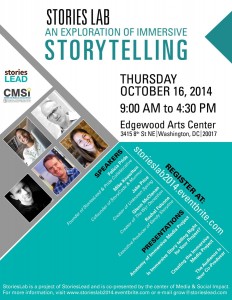Immersive storytelling is not just another a fancy buzzword. It’s a great tool filmmakers, journalists, artists and producers use to engage audiences through a captivating, first person interactive experience online and share their messages and stories with the users.
storytelling is not just another a fancy buzzword. It’s a great tool filmmakers, journalists, artists and producers use to engage audiences through a captivating, first person interactive experience online and share their messages and stories with the users.
On October 16, the Pride Collaborative presented “StoriesLab,” a day long interactive exploration into immersive storytelling with presentations from those who already learned how to master it.
What is immersive storytelling?
Glenn McClann, creator of “The Wyr Deception”, explained what immersive storytelling is not. He said it’s not just a cross-platform media or simply interactive content on social media, rather it’s an online compelling experience, which places the user as part of the story. According to McClann, the idea itself is not new, what is new, is the technology and web environment allowing immersive storytelling. New programing tools such as HTML5, Flash or D3.js for example, along with web abilities such as high quality file compressing and a faster upload speed, allow storytellers to incorporate high quality images, sounds, videos, games, and other elements in their work and to draw the audience into their online worlds.
Succeeding in creating such experience is not an easy task and it is not for everyone. While McClann did say immersive storytelling is unique and limitless, he also said it is often expensive, many times misunderstood and demands technological literacy. Therefore, creators should always ask: is immersive storytelling the right way to tell your story? And if it is, how immersive does it need to be?
Where can we find immersive storytelling?
There are some great examples for immersive storytelling such as The New York Time’s “Snow Fall”, the Guardian’s “Firestorm” and interactive documentaries like “Hollow” and “Last Hijack”. All use different elements such as full screen videos and images, music, interviews, text, social media, animation and maps.
Jack Price, who is responsible for “Unknown Spring” and the “The Invisible Season”, said he hopes that by sharing the stories of the victims of the 2011 tsunami and the Fukushima Daiichi Nuclear Power Station meltdown in Odeka, Japan, he will help bring global awareness to the survivors’ situations and awareness to the risks of nuclear energy. While “Unknown Spring” is more of a documentation of the disaster area, “The Invisible Season” is more personal, showcasing testimonies of residents alongside a timeline of events and a map showing radiation levels. Price has been working on these projects for over four years. He said his next goal is to use immersive media to help the community by rebranding it as a beautiful countryside with strong and able residents who have history, culture and future, rather than a wasteland and the people as victims.
Immersive storytelling requires knowledge of new technologies and tools, which might be a deterrent for newcomers. Mike Knowlton, co-founder of Storycode and Murmur, said creators should not fear. As you attempt to go deeper into creating an immersive experience, try to think like a programmer. This means thinking about how the technology can help in telling the story, both the new capacity and the limitations. This requires some tech-savviness, but as Knowlton explained, there are free tools and tutorial for almost everything online. Good places to check would be tutorialspoint.com, which offers many web development and programming manuals.Interlude and Racontr are companies that developed web apps to create immersive media products online and have explanations on how to use on their platforms.
As immersive storytelling becomes more common, it expands into different fields such as film, documentaries, advertising and public media. It could spell new opportunities for media impact as the format engages audiences with new experiences and narratives.
